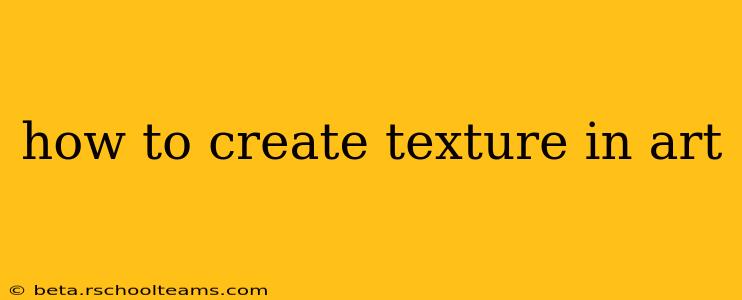Creating texture in art is crucial for adding depth, realism, and visual interest to your artwork. Whether you're working with paint, sculpture, drawing, or digital media, understanding how to manipulate texture can significantly elevate your artistic expression. This guide will explore various techniques and approaches to help you master the art of creating texture.
What is Texture in Art?
Texture in art refers to the surface quality of an artwork, how it feels or appears to feel to the touch (actual texture) or to the eye (implied texture). Actual texture is physical; you can feel the bumps, grooves, and variations. Implied texture, on the other hand, is an illusion created through artistic techniques to suggest a tactile experience. Mastering both is key to creating compelling artwork.
How to Create Actual Texture in Art
Actual texture is achieved through the use of materials and techniques that physically alter the surface of your artwork. This is particularly common in sculpture, printmaking, and mixed-media art.
Techniques for Creating Actual Texture:
- Impasto: This painting technique involves applying thick layers of paint to the canvas, creating a three-dimensional effect. The paint itself becomes the texture. Think of Van Gogh's thick brushstrokes.
- Collage: Incorporating different materials like fabric, paper, or found objects onto your canvas introduces varied textures. This is a great way to add contrasting elements and create a dynamic surface.
- Modeling: In sculpture, modeling involves shaping pliable materials like clay or wax, allowing for incredibly detailed and varied textures.
- Printmaking: Techniques like etching, embossing, and woodblock printing naturally create textured surfaces on the final print.
How to Create Implied Texture in Art
Implied texture relies on visual cues to suggest a tactile experience. This is commonly used in painting, drawing, and digital art.
Techniques for Creating Implied Texture:
- Value and Tone: Using variations in light and shadow can convincingly suggest texture. Darker areas can create a sense of depth and recession, while lighter areas can suggest raised surfaces.
- Line: The direction, weight, and density of your lines can significantly impact the perceived texture. Closely spaced, short lines might imply roughness, while long, flowing lines could suggest smoothness.
- Color: Color variations can subtly suggest texture. For instance, a duller, more muted color palette might imply a rougher surface, while bright, saturated colors could suggest smoothness.
- Brushstrokes: The type of brush and the way you apply paint can drastically alter the implied texture. Loose, expressive brushstrokes can create a sense of movement and energy, while precise, controlled strokes suggest smoothness.
What are some common materials used to create texture?
Many materials can be used to create texture, depending on the desired effect and the art form.
- Paints: Acrylics, oils, watercolors – each offers unique textural possibilities depending on application and mediums used.
- Drawing Materials: Charcoal, graphite, pastels, colored pencils – these vary significantly in their ability to create texture.
- Mixed Media: Fabric, paper, sand, wood, metal, beads – these materials introduce a wider range of actual textures.
- Sculpting Materials: Clay, wax, plaster, stone – these directly determine the final tactile surface of a sculpture.
How do I choose the right texture for my artwork?
The choice of texture depends heavily on your artistic vision and the overall effect you want to achieve. Consider the mood, subject matter, and style of your artwork. A rough texture might suit a landscape depicting a rocky terrain, while a smooth texture could be appropriate for a portrait. Experiment with different techniques and materials to discover what best expresses your artistic intent.
How can I improve my skills in creating texture?
Practice is key! Experiment with different techniques and materials, studying the work of masters who excel at creating texture. Observe the world around you – pay attention to the textures of objects and how light interacts with them. Try recreating these textures in your art.
By understanding and mastering these techniques, you can confidently incorporate texture into your artwork, adding depth, realism, and a captivating sense of tactility. Remember, texture is a powerful tool that can transform your artistic vision into a truly compelling and engaging experience for the viewer.
